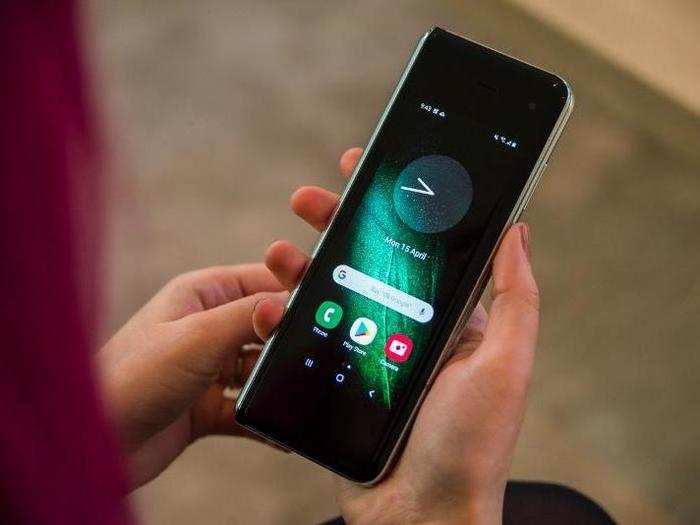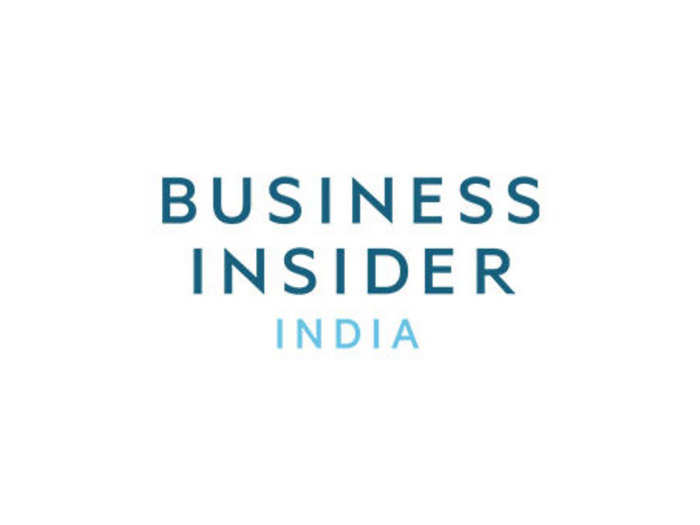
At a time when most phones offer screens larger than five inches, the Galaxy Fold feels tiny as a smartphone when closed.
While apps work adequately on this front screen, I can see myself using it primarily as a cover that I'd occasionally glance at to check the time or read a notification. It doesn't seem to be ideal for anything more than that.

Because the AMOLED displays Samsung uses for its smartphones are capable of delivering deep blacks, it almost looks like the screen is floating in the center of the device's cover.
But Samsung intentionally kept the display from occupying the entire front of the device to maintain a 21:9 aspect ratio. Elongating the screen to match the size of the phone itself would likely make for an awkward experience when using apps.

It's chunky for a smartphone, but I imagine most people who purchase the Fold will be using it in tablet mode more often.
Unlike many newer smartphones, there is a fingerprint sensor along the side of the device.

When unfolded, the device feels like it's just the right size for most of the activities I'd normally engage in on a phone or a tablet.
Not only is the screen and aspect ratio ideal for consuming media, but the device also feels much thinner and lighter than most tablets of the same size. Samsung says it uses an advanced composite polymer screen for the Fold's inner display, which is 50% thinner than the average smartphone screen.

Samsung has been working with app developers to ensure that apps work smoothly on both the 4.6-inch screen and the 7.3-inch display. During the brief time I had with the device, I found that apps like Google Maps, YouTube, and Spotify transitioned from phone mode to tablet mode instantly as I unfolded the phone.

Samsung has offered the ability to run two apps in split screen mode on its smartphones for years, but it's taken that one step further with the Galaxy Fold.
Simply swiping in from the right of the screen will pull up a sidebar from which you can select a new app to open alongside the one that's currently in use. You can also adjust the size of these windows by dragging the divider on-screen accordingly.

With its glossy, mirror-like finish and dual screens, the Galaxy Fold may look delicate. But it certainly didn't feel fragile when you're using it, at least during my experience with the device; opening and closing the Galaxy Fold doesn't feel much different than snapping shut a flip phone.
Samsung says the phone's dual-axis hinge is built to withstand 200,000 folds and unfolds, which means it's designed to last for at least five years if you open and close it 100 times per day. Of course, we won't have a better sense of the phone's durability until we've used it for a longer period of time.

The Galaxy Fold has a 10-megapixel selfie camera situated on the front of the device when folded, another 10-megapixel selfie camera and an 8-megapixel depth camera on the inside when the phone is in tablet mode, and a triple-camera system on the phone's back.
The camera placement makes it possible to shoot photos or video no matter which mode the Fold is in. I did notice, however, that I had to be careful not to place my finger over the inner front-facing cameras when holding the device in its landscape orientation when in tablet mode.

That triple camera arrangement on the back of the Galaxy Fold includes a 12-megapixel telephoto lens, a 12-megapixel wide-angle lens, and a 16-megapixel ultra-wide camera.

But I can also imagine that snapping a photo with one hand could be tricky when using the Fold in tablet mode.

The term "phablet"— a portmanteau of phone and tablet — has been around for years, but no device has embodied it quite as well as the Galaxy Fold.
Its sky-high price will likely make it a difficult purchase for most, but it's a compelling proposition for how smartphones will evolve beyond the static touchscreen slates we're accustomed to today.
 I spent $2,000 for 7 nights in a 179-square-foot room on one of the world's largest cruise ships. Take a look inside my cabin.
I spent $2,000 for 7 nights in a 179-square-foot room on one of the world's largest cruise ships. Take a look inside my cabin. Saudi Arabia wants China to help fund its struggling $500 billion Neom megaproject. Investors may not be too excited.
Saudi Arabia wants China to help fund its struggling $500 billion Neom megaproject. Investors may not be too excited. One of the world's only 5-star airlines seems to be considering asking business-class passengers to bring their own cutlery
One of the world's only 5-star airlines seems to be considering asking business-class passengers to bring their own cutlery From terrace to table: 8 Edible plants you can grow in your home
From terrace to table: 8 Edible plants you can grow in your home
 India fourth largest military spender globally in 2023: SIPRI report
India fourth largest military spender globally in 2023: SIPRI report
 New study forecasts high chance of record-breaking heat and humidity in India in the coming months
New study forecasts high chance of record-breaking heat and humidity in India in the coming months

Copyright © 2024. Times Internet Limited. All rights reserved.For reprint rights. Times Syndication Service.